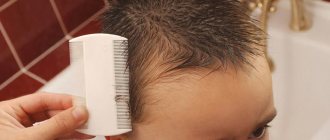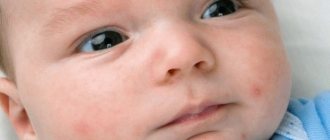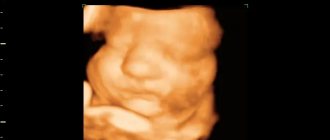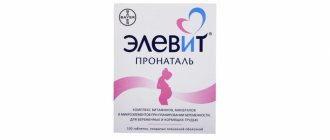Miliaria is a rash in the form of transparent blisters or red nodules, which occurs due to blockage of the sweat glands and is most often caused by overheating of the body. Based on the nature of the rashes, they distinguish between red, crystalline and papular miliaria. The diagnosis of prickly heat usually does not cause difficulties; consultation with a dermatologist may be required only in complicated cases. Treatment of prickly heat consists mainly of eliminating the factors that cause overheating and increased sweating of the body. Measures to prevent prickly heat include optimal room temperature, weather-appropriate clothing, personal hygiene and proper skin care.
What is prickly heat and why does it occur?
This is exactly the case when the name of the disease speaks for itself. Miliaria occurs when a person sweats frequently. At the same time, the excretory ducts of the sweat glands become blocked and a rash appears. Most often, the disease manifests itself in closed areas of the body - on the back, neck, legs, buttocks, armpits, and also in skin folds. If parents put a hat on their baby that is out of season, heat rash can appear on the head and even on the face, especially in those places where hair falls on the skin.
| Our expert Polina Vasilyeva dermatologist |
| Most often, heat rash can be noticed in those places on the body where it is damp and warm, primarily under the diaper. Heat rash also affects areas of the skin that have difficult access to air - the neck, upper chest, back, crooks of the arms and legs, armpits, lower back, behind the ears and in various skin folds. |
Miliaria occurs not only in children, but in adults too, but much less frequently. The reasons are quite obvious. Firstly, the baby's skin is softer and thinner. Secondly, the thermoregulation of a child under one year old is very far from ideal - he easily becomes hypothermic and even more easily overheats. Finally, an adult is able to understand that he is hot and take off excess clothes, but a newborn is completely dependent on the will of his parents. That is why the likelihood of heat rash in a one-month-old baby is much higher.
| Our expert |
Polina Vasilyeva
dermatologist
| This disease most often occurs in young children, since their thermoregulation nerve centers are still imperfect and almost do not function. Sweating develops during the first two years of a child's life. Due to functional immaturity and a number of other factors, the sweat glands become blocked and a rash forms on the skin - miliaria. Factors influencing its appearance include, for example, incorrectly selected diapers, excessive wrapping of young children, lack or insufficiency of air baths, and much more. |
How to distinguish heat rash from allergies in a newborn
Seeing any rash on the skin of a newborn, a nursing mother first of all begins to worry whether she has eaten something forbidden, which has led to an allergy in the baby. In a panic, she may refuse all possible allergens, including foods necessary for the body, and this, together with stress, can have a bad effect on lactation. If the baby is bottle-fed, then he doesn’t need an unreasonable change of formula due to suspected allergies. Therefore, before making any decisions, any skin symptoms should be shown to a doctor to clarify the diagnosis.
Before visiting a doctor, take a look at what the rash looks like and where it is located, this will help determine the nature of its origin.
| Prickly heat | Allergy | |
| Dependence on the time of year, temperature, room humidity | Eat | No |
| Where do rashes form? | Folds, skin under hair, back of neck and back under clothing, armpits, groin - all poorly ventilated areas | Face (often cheeks), front surface of the chest and abdomen, arms, legs. |
| Nature of the rash | Isolated small clear or red bubbles | The rash may initially appear as separate elements in the form of small blisters and papules, often on a red background of the skin; the rash may merge into spots |
| Skin under rashes | Usually unchanged or slightly red and swollen | Dry, often red, prone to flaking or weeping areas with crusting, often itching |
| Additional symptoms (runny nose, cough, watery eyes) | No | Can be |
List
- Miliaria in newborns looks like small red or transparent bubbles with liquid, located in places of friction and contact of the skin with clothing.
- Miliaria occurs due to blockage of the sweat glands, the functioning of which in an infant is not yet perfect, in hot, humid conditions.
- Heat rash should be treated with hygiene procedures and the selection of loose clothing made from natural fabrics. Creams and ointments cannot be used without a doctor's prescription.
- Miliaria can be distinguished from allergies by the nature of the rash: the blisters are small, do not merge, and the skin underneath is not inflamed. Appears in hot weather and rarely bothers the child.
(0 ratings; article rating 0)
Share Share Share
What does prickly heat look like in children?
At first, the symptoms look quite harmless - just a little redness. It is very important not to cause heat rash in a child: in the initial stages of development it is easy to get rid of, but later treatment may be required. The disease goes through the following stages:
- If parents do not think about how to remove heat rash from their child, or fight it incorrectly, the disease can move from the surface of the epidermis into the deeper layers of the skin. The inflammatory process begins and redness appears around the blisters.
- In advanced cases, bacteria penetrate the bubbles, causing their contents to become cloudy, and this looks very unpleasant not only in life, but even in the photo. The amount of rash increases, the skin begins to get wet. The disease develops especially quickly if the newborn is weakened.
- Mild redness of the skin, sometimes accompanied by itching. The baby may reach out to irritated areas, touch and scratch them.
- If the child continues to overheat, a rash appears in the red areas in the form of tiny blisters filled with clear liquid. They look almost like beads of sweat appearing, but only in a shell.
- If parents do not think about how to remove heat rash from their child, or fight it incorrectly, the disease can move from the surface of the epidermis into the deeper layers of the skin. The inflammatory process begins and redness appears around the blisters.
- In advanced cases, bacteria penetrate the bubbles, causing their contents to become cloudy, and this looks very unpleasant not only in life, but even in the photo. The amount of rash increases, the skin begins to get wet. The disease develops especially quickly if the newborn is weakened.
- Mild redness of the skin, sometimes accompanied by itching. The baby may reach out to irritated areas, touch and scratch them.
- If the child continues to overheat, a rash appears in the red areas in the form of tiny blisters filled with clear liquid. They look almost like beads of sweat appearing, but only in a shell.
Don't let heat rash develop and become a problem that requires treatment. When the first symptoms appear on the baby’s back, head, face or other places on the baby’s body, eliminate the cause of overheating. If this doesn't help, consult a doctor!
| Our expert |
Polina Vasilyeva
dermatologist
| Miliaria does not require special treatment. It is necessary to change the care regimen and keep the baby's skin clean to avoid infection. |
In cases where prickly heat has developed from redness to a rash, and then bacterial infection occurs, treatment with special creams and ointments may be prescribed. If the symptoms show that the disease has reached a serious stage, consult a doctor and he will tell you how to treat it. Take regular photos of problem areas to track progress.
| Our expert |
MUTRINA - WHAT TO TREAT
— Alla Anatolyevna, how do you feel about home self-treatment of prickly heat?
— In case of any rashes, changes in skin condition, blisters or redness, it is better to visit a doctor. If it is not possible to quickly get an appointment, you can try to help the child yourself. But the lack of improvement is always a reason to consult a pediatrician (and for adults, a dermatologist).
— How to get rid of heat rash in a newborn?
— Miliaria is not a very dangerous disease and does not affect health. But the condition is unpleasant - unsightly red spots, itching, dryness, burning. If prickly heat is noticed in time, there are no purulent complications from the skin fatty tissue, treatment is started early, everything goes away within 7-10 days.
Polina Vasilyeva
dermatologist
| Rashes can be treated with products containing zinc oxide (sudocrem), or diaper cream, powder. If you are concerned about itching, a cream with dexapanthenol (“Bepanten”, “Bepanten plus”, “Cicaplast”) or soothing creams that are sold in pharmacies will help. The products “Drapolen”, “Bepanten”, “Desitin” - their It is recommended to apply a thin layer and do not put on the diaper until completely absorbed. |
How to prevent heat rash in a child?
Prevention of heat rash is very simple - you just need to make sure that the child is comfortable and does not sweat. Here is a list of rules you need to remember:
- Create the right climate in your baby's room. Maintain the temperature at 18–20 °C and don’t worry that the newborn will freeze - this will be just right for him.
- If your baby's crib is exposed to direct sunlight, move it to a different location.
- Ventilate the room regularly, do not allow the air to stagnate.
- Do not buy clothes for your baby made from synthetic fabrics that do not breathe. Choose natural.
- Bathe your baby daily.
- Do not wrap your child up - both at home and on walks.
- Change diapers at least every 3-4 hours. After you've removed the used diaper and dried your baby's skin, let her breathe for a few minutes.
Learn to recognize the symptoms of overheating. If the child becomes lethargic and his face turns red, it means he is very hot. During a walk, especially in the cold season, these signs are easy to miss: the baby’s face, as the only open part of the body, rather reflects the weather outside than the general condition of the body. Gently slide your hand under your baby's clothes and check the back of the neck. If the baby's skin is dry and warm, everything is fine, but if it is wet, the baby is overheated, and this may result in the appearance of heat rash.
How to distinguish heat rash from allergies in a child?
An allergy is a pathological reaction of the immune system, and it is usually not exchanged for such trifles as local redness on the face or back. Allergy symptoms manifest themselves in a complex manner, often accompanied by nasal congestion and runny nose, shortness of breath, and redness of the eyes. If at the same time a rash is discovered on the baby’s body, the raging immune system usually “draws” mirror pictures. For example, skin problems occur on both elbows at once, rashes appear on the stomach or groin, symmetrical relative to the center line of the body.
The allergy usually comes out in the form of eczema (distinguished by the formation of tiny blisters that burst very quickly and leave weeping wells) or urticaria (almost unmistakably recognized by raised, flat blisters). These symptoms are completely different from prickly heat. If in doubt, look on the Internet for photos of these skin diseases. Better yet, take a photo of the problem skin area yourself and send it to the doctor.
Due to inexperience, other skin diseases can be mistaken for heat rash in a child, but they also have their own distinctive characteristics.
- Miliaria and contact dermatitis
Contact dermatitis is a direct response of the skin to an irritant and, true to its name, is always limited to areas of contact. For example, if the problem is in the composition of new socks, redness will appear on the legs, right under them, and if in the new shampoo, on the head.Dermatitis occurs quite easily and spontaneously in dry places - where prickly heat has nothing to do. And he’s in no hurry to leave—days, sometimes weeks, pass before the symptoms of this disease disappear.
- Heat rash and diaper rash
Diaper rash also likes warm and humid places, but has a different cause. They occur as a result of the development of a bacterial infection in irritated or chafed areas of the skin on the neck, groin, armpits and other places. Diaper rash is more painful for newborns and children under one year old, because they have many secret folds on the body.At the first stage of development, diaper rash shows the same symptoms as prickly heat - redness on the skin. Later, cracks appear in these places, then ulcers. The fact that it is almost impossible to distinguish these two diseases in the early stages should not upset you. Start treatment on two fronts at once - diaper rash cream plus control and prevention of overheating from prickly heat. One will help, and the other definitely won't hurt.
Causes and symptoms of allergies
Many different factors can cause an allergic reaction - food, household chemicals, animal hair and pollen, fabrics, medications and even ultraviolet radiation. Sometimes even this knowledge is enough to distinguish allergies from prickly heat. If you've recently made changes to your usual diet, started taking new medications, or changed brands of laundry detergent, these factors are likely to be the cause of your breakouts. However, allergies can also arise unexpectedly - for example, if you have never previously noticed a negative reaction of the body to dog hair, and have only recently encountered this problem. In this case, special tests can help - they will not only help establish the presence of an atypical reaction to certain irritants, but will also help identify a specific allergen.
Usually, to get rid of the symptoms of prickly heat, it is enough to eliminate the factors that cause waterlogging and contamination of the skin - most often this is a lack of hygiene, poor ventilation of the skin due to clothing, or staying in hot and poorly ventilated rooms. In most cases, symptoms quickly disappear after this. An allergic rash is much more persistent: it is difficult to treat and does not always go away even after eliminating contact with the allergen.









